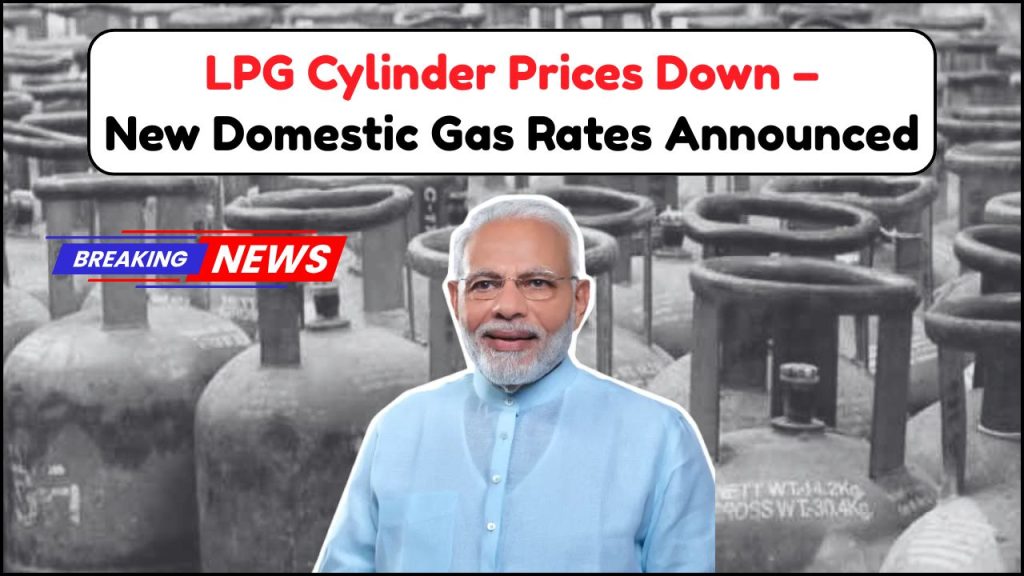
After months of financial strain from rising living costs, Indian households finally have something to smile about. The government has rolled out fresh cuts to LPG cylinder prices nationwide, delivering a welcome breather to families already juggling tight budgets. This latest price revision specifically targets domestic cooking gas cylinders, addressing concerns that have been brewing among consumers for quite some time.
The announcement comes as a pleasant surprise for millions of families who rely on LPG for their daily cooking needs. With kitchen expenses forming a significant chunk of household budgets, even modest savings can make a meaningful difference in monthly planning. The timing couldn’t be better either, as families gear up for increased cooking during the festive months ahead.
Breaking Down the Numbers: What’s Changed in Your City
The price reduction isn’t uniform across the board – it varies slightly from city to city based on local logistics and tax structures. However, the government has ensured that the relief reaches every corner of the country fairly.
| Major Cities | Old Price (₹) | New Price (₹) | You Save (₹) |
|---|---|---|---|
| Delhi | 903 | 853 | 50 |
| Mumbai | 902.50 | 852.50 | 50 |
| Kolkata | 929 | 879 | 50 |
| Chennai | 918.50 | 868.50 | 50 |
| Bengaluru | 905.50 | 855.50 | 50 |
| Hyderabad | 955 | 905 | 50 |
| Ahmedabad | 910 | 860 | 50 |
| Chandigarh | 912 | 862 | 50 |
The consistent ₹50 cut across major metropolitan areas shows the government’s commitment to uniform relief. For families using one cylinder monthly, this translates to ₹600 in annual savings – money that can now go toward other essential needs or small luxuries that make life a bit easier.
The Story Behind the Price Drop: Why Now?
Several factors have converged to make this price reduction possible, and understanding them helps us appreciate why this relief has arrived now. The primary driver has been the stabilization of international crude oil markets, which directly influences LPG pricing since cooking gas is a petroleum derivative.
Political dynamics have also played their part. Opposition parties and consumer advocacy groups have been consistently highlighting the burden of rising fuel costs on ordinary families. With several state elections scheduled and public sentiment closely watched, the government has responded to these legitimate concerns with concrete action.
The festive season timing isn’t coincidental either. Households typically see increased cooking activity during festivals, marriages, and celebrations. By reducing prices now, the government aims to ease the financial pressure during these traditionally expensive periods when families already stretch their budgets.
International market conditions have been favorable too. Global crude prices have shown relative stability, creating room for domestic price adjustments without compromising the country’s energy security or fiscal health.
Home vs Business: Understanding Different LPG Markets
The LPG market operates on two distinct tracks – domestic and commercial, each with its own pricing logic and subsidy structure. While families celebrate the domestic price cuts, businesses also benefit from parallel reductions in commercial cylinder rates.
| Cylinder Category | Size | Previous Rate (₹) | Current Rate (₹) | Savings (₹) |
|---|---|---|---|---|
| Household (Domestic) | 14.2 kg | 903 | 853 | 50 |
| Business (Commercial) | 19 kg | 1,769 | 1,709 | 60 |
The distinction matters because domestic cylinders receive government subsidies or partial support, making them more affordable for regular families. Commercial cylinders, used by restaurants, hotels, and small industries, operate closer to market rates without the same level of government cushioning.
This dual structure ensures that household cooking remains affordable while allowing businesses to access LPG at competitive rates that reflect global market conditions more directly.
Going Digital: Modern Ways to Track LPG Prices
Gone are the days when you had to call your local gas agency or visit them physically to check current prices. India’s three major LPG suppliers have embraced digital transformation, offering multiple ways for consumers to stay updated on pricing and services.
- Indian Oil’s Indane Services: Their website, indane.co.in, and mobile app provide comprehensive price information, booking facilities, and subsidy tracking. The platform is user-friendly and offers services in multiple regional languages.
- Hindustan Petroleum’s HP Gas: The myhpgas.in portal serves as a one-stop solution for price checking, online bookings, and customer support. Their mobile app integrates seamlessly with digital payment systems.
- Bharat Petroleum’s Bharat Gas: Through ebharatgas.com, customers can access real-time pricing, track deliveries, and manage their connections. The platform also provides helpful usage tips and safety guidelines.
Using these digital platforms is straightforward: visit the website or open the app, navigate to the price section, enter your location details, and get instant access to current rates in your area.
The Subsidy Revolution: How Direct Benefits Work
India’s Direct Benefit Transfer system has transformed how LPG subsidies reach consumers, eliminating intermediaries and ensuring that benefits go directly to those who deserve them. This system represents a significant improvement over older methods that were prone to leakage and misuse.
Here’s how the current system operates: eligible consumers pay the full market price when their cylinder is delivered. Within a few days, the subsidy amount gets credited directly to their linked bank account. This approach ensures transparency and prevents subsidy diversion while maintaining consumer choice.
The system requires consumers to maintain updated documentation, including Aadhaar linking and current bank account details. While this might seem cumbersome initially, it guarantees that subsidies reach genuine beneficiaries rather than getting lost in bureaucratic channels.
Consumers can easily track their subsidy status through their gas provider’s website, mobile app, or the dedicated LPG Seva application. The system also sends SMS notifications when subsidies are processed, keeping consumers informed about their benefits.
Smart Strategies to Stretch Your Gas Budget Further
While the price reduction provides immediate relief, smart cooking practices can amplify these savings significantly. Small changes in kitchen habits often yield surprising results in gas consumption reduction.
- Equipment efficiency makes a difference: Investing in ISI-certified gas stoves ensures optimal fuel utilization. These stoves are engineered for complete combustion and better heat transfer, reducing wastage that occurs with inefficient burners.
- Cooking methodology matters: Planning your cooking sequence helps utilize residual heat effectively. Starting with dishes that require high heat and progressing to those needing lower temperatures maximizes energy efficiency.
- Maintenance pays off: Keeping burners clean ensures proper gas flow and complete combustion. Blocked or dirty burners can increase consumption by up to 15-20%, making regular cleaning a worthwhile investment.
- Smart cookware choices: Using appropriately sized pots for your burners ensures maximum heat transfer. Covering pots with lids during cooking traps heat and steam, significantly reducing cooking times.
- Preventive care: Annual servicing of your gas connection prevents leaks and ensures optimal performance. Even minor leaks can result in substantial gas wastage over time, making professional maintenance cost-effective.
Consumer Voices and Market Predictions
The price reduction has generated widespread positive responses across the country, with social media platforms buzzing with messages of relief and appreciation. Middle-class families, in particular, have expressed gratitude for this timely intervention during challenging economic times.
However, consumer reactions also reflect a cautious optimism born from previous experiences with fuel price volatility. Many families remember instances where price reductions were followed by subsequent increases, making them appreciate current savings while remaining watchful about future trends.
Market analysts view this move positively, predicting that reduced prices could stimulate increased LPG adoption, particularly in rural areas where price sensitivity traditionally influences fuel choices. This could accelerate India’s progress toward universal clean cooking fuel access.
Industry experts suggest that sustained lower prices could encourage more households to switch from traditional cooking methods to LPG, supporting both environmental goals and public health objectives. The reduction might also boost consumer confidence and spending in other sectors.
Future Outlook: Sustainability and Long-term Implications
The sustainability of these reduced prices depends on various factors beyond government control, including global crude oil trends, geopolitical developments, and domestic economic conditions. However, the government’s commitment to maintaining affordable cooking fuel access remains a policy priority.
Energy sector analysts emphasize that this price reduction should be viewed within the broader context of India’s energy transition goals. The government’s push for LPG adoption aligns with environmental objectives and efforts to reduce indoor air pollution, particularly in rural households.
The success of this initiative will be measured not just in immediate consumer relief but also in its contribution to achieving universal access to clean cooking fuels. This aligns with India’s sustainable development goals and commitments to reducing carbon emissions from traditional biomass burning.
Looking ahead, the government faces the challenge of balancing affordable pricing with fiscal sustainability. The approach taken with this price reduction – responding to market conditions while maintaining social welfare objectives – suggests a pragmatic policy framework that could guide future decisions.
Regional Impact and Economic Ripple Effects
The uniform price reduction across cities demonstrates the government’s commitment to ensuring that geographic location doesn’t determine access to affordable cooking fuel. This approach particularly benefits smaller cities and towns where transportation costs traditionally made LPG more expensive.
Rural areas, where LPG adoption has been steadily increasing through various government schemes, stand to benefit significantly from these reduced prices. Lower costs could accelerate the transition away from traditional cooking fuels, supporting both health and environmental objectives.
The economic implications extend beyond individual households. Reduced cooking fuel costs can indirectly support small businesses, street food vendors, and home-based food enterprises that rely on LPG for their operations. This could have positive effects on employment and entrepreneurship in the informal economy.
Quick Answers to Common Questions
Q: Are the new LPG prices effective immediately?
A: Yes, the reduced prices are applicable right away across all participating cities.
Q: Will my subsidy amount change with the new pricing?
A: Subsidy calculations will be adjusted to reflect the new base prices automatically.
Q: Do I need to inform my gas agency about wanting the reduced price?
A: No action required – the new prices will apply automatically to your next cylinder purchase.
Q: Are there any changes to commercial LPG pricing as well?
A: Yes, commercial cylinders have also received price reductions alongside domestic ones.

Mangesh garg is a passionate writer known for captivating stories that blend imagination and reality. Inspired by travel, history, and everyday moments, He crafts narratives that resonate deeply with readers.



